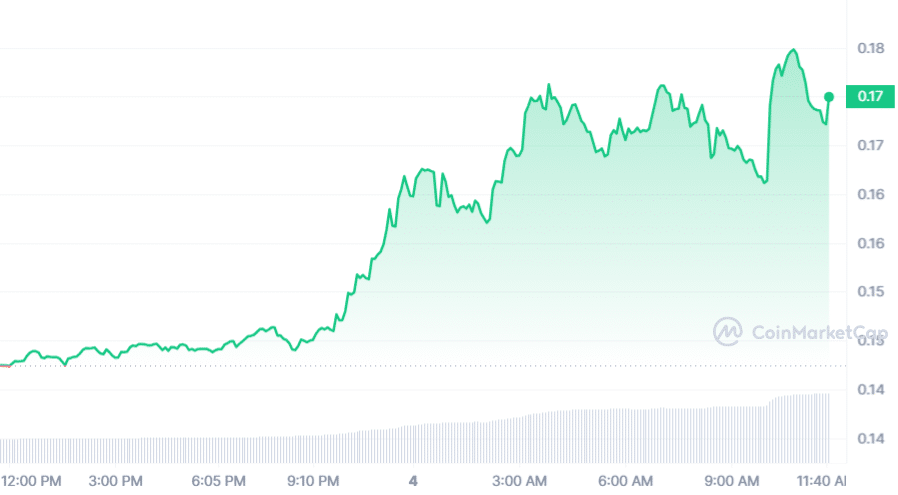KAS, the native token of the proof-of-work cryptocurrency Kaspa, has soared 20% as its price nears a potential all-time high.
At the time of writing, Kaspa (KAS) has experienced a 200% increase in trading volume and an 18% increase in price during the previous 24 hours. The cryptocurrency asset has risen 25% in the previous seven days and 61% in the last 30 days, indicating an optimistic prognosis for the altcoin this month.

According to CoinMarketCap, the token now ranks 26th in the global cryptocurrency list, with a trade price of $0.176, a circulating supply of around 23,828 million KAS tokens, and a market capitalization of $4.09 billion.
Kaspa is a cryptocurrency designed to provide a high-performance, scalable, and secure blockchain platform. Kaspa’s distinguishing feature is its usage of the GhostDAG protocol, which enables faster block times and higher transaction throughput than typical blockchains. GhostDAG, unlike standard blockchains, does not create orphan blocks in parallel. Instead, GhostDAG lets them to cohabit while enforcing consensus.
The current price increase follows a June 3 X post by trader Christian Ludwig, who pointed out the potential catalysts that are likely to drive the price of Kaspa to as high as $1 in the coming months. Among them is the introduction of Kaspa KRC20 smart contracts, the Kaspa network’s potential to rise as the next best stablecoin transfer network.
Other potential drivers cited by Ludwig to reach the price target were the Ethereum Virtual machine bringing the ETH network to Kaspa and an upcoming Blockdag upgrade that will boost its network speed by up to 10 times.
Earlier on May 30, Kaspa’s hashrate had grown to approximately 300 PH/s, which remains a fraction of Bitcoin’s hashrate. However, the rate remains approximately 20 times higher than Ethereum Classic’s, making it more difficult to attack.
Kaspa’s network is based on one of Satoshi Nakamoto’s previous concepts. Bitcoin’s creation schedule was expected to be substantially shorter. This idea prompted Kaspa to provide rapid currency production, with halving occurring more frequently.
Kaspa will, at max, contain a total of 28.7 billion coins, with a halving occurring every year. At the current hashrate, more than 23 billion coins have already been produced, accounting for more than 82% of the total supply. The competition to mine the remaining coins will intensify, and miners will be forced to cover their costs through fees.
The majority of KAS trading takes place through ByBit, Gate.IO, and KuCoin, while the crypto community hopes for a Binance listing. As Kaspa’s popularity grows, miners may try to amass coins in the hopes of seeing positive price action.
Because of its huge supply, KAS is relatively noticeable, nearly cracking the top 25 assets by market capitalization.
Kaspa has been distributed to approximately 500K addresses, holding more than a “dust” amount. However, People are adopting Kaspa at a slow pace in 2024 because they are more interested in meme tokens, which are easier to acquire.
The Kaspa community anticipates a price increase of $1 from present levels. However, KAS can only rise up if L1 narratives return to the forefront. Kaspa’s blockchain leverages its DAG structure, speed, and mining to boost its influence. The network is still behind in token creation and value-generating projects.
This article first appeared at crypto.news
